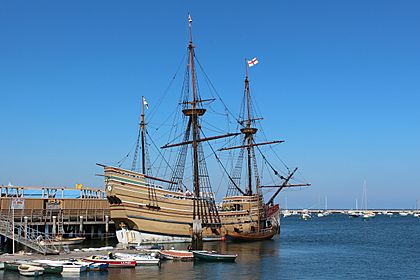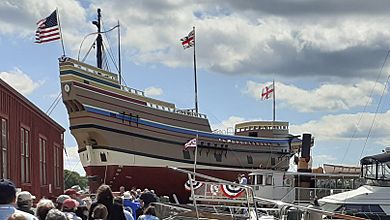Mayflower II facts for kids

Mayflower II at State Pier in Plymouth, Massachusetts, 2006
|
|
Quick facts for kids History |
|
|---|---|
| Name | Mayflower II |
| Namesake | Mayflower |
| Owner | Plimoth Plantation |
| Builder | Upham Shipyard, Brixham, Devon |
| Laid down | July 27, 1955 |
| Launched | September 22, 1956 |
| Christened | by Stewart Upham & Reis Leming |
| Status | Museum ship |
| General characteristics | |
| Displacement | 238 long tons (242 t) |
| Length |
|
| Beam | 25 ft 6 in (7.77 m) |
| Draft | 13 ft (4.0 m) |
| Sail plan | 3-masted ship |
| Armament | 2 × 3-pounder minion stern chasers |
The Mayflower II is a special ship that looks exactly like the original Mayflower. That first Mayflower was famous for carrying the Pilgrims to the New World (America) in 1620.
This replica ship was built in Devon, England, between 1955 and 1956. It was a team effort between an Englishman named Warwick Charlton and Plimoth Plantation, a museum in America. They used old ship plans that were put back together and built the ship by hand using traditional methods.
The Mayflower II sailed from Plymouth, Devon, on April 20, 1957. It followed the same path as the first Mayflower across the Atlantic Ocean. Alan Villiers was the captain of this journey.
The ship's logbook says Mayflower II arrived in Plymouth, Massachusetts, on June 22. It was then pulled by a tugboat into New York City on July 1, 1957. Captain Villiers and his crew received a big parade with lots of paper streamers. In 2020, the ship was recognized as an important historical place in the US.
The Mayflower II was built at the Upham Shipyard in Brixham. The money for its construction came from private donations in England and from Plimoth Plantation. This project showed the strong friendship between the United Kingdom and the United States after they worked together in World War II.
The ship is a very accurate copy of the original. It has strong oak wood, ropes made from tarred hemp, and maps colored by hand. It is 106 ft (32 m) long and 25 ft (7.6 m) wide. It weighs 236 tons and has three masts (mainmast, foremast, mizzen), a bowsprit, and 6 sails.
The ship can sail safely on the ocean. In 2002, it sailed to Providence, Rhode Island. In December 2012, Mayflower II was pulled into a special dock in Fairhaven, Massachusetts, for repairs. More damage was found than expected, so the repairs took longer. The ship returned to its home in Plymouth on August 7, 2013. In December 2015, it went to Mystic, Connecticut, for more restoration work. It came back to Plymouth for the summer of 2016 and returned permanently in 2020. This was just in time for the 400th anniversary of the Pilgrims' arrival.
Contents
Building the Mayflower II
In August 1954, a man named Warwick Charlton had an idea. He wanted to build a copy of the Mayflower to celebrate how the United Kingdom and the United States worked together during World War II. He had fought alongside American soldiers in North Africa. So, in 1955, "Project Mayflower" was started to build the ship in England and sail it to the US. This would be a symbol of friendship.
The people behind the project wanted to make sure the ship would be taken care of after it arrived in the United States. They knew that other replica ships had rotted away when people lost interest. Project Mayflower learned about the Plimoth Plantation museum. In March 1955, John Lowe from Project Mayflower came to the US. He met with the museum to get help with keeping and showing Mayflower II.
Ship Design and Construction
Plimoth Plantation had already planned to add a Mayflower replica to its exhibits years before. In 1951, the museum had asked William A. Baker, a ship designer from MIT, to draw plans for a Mayflower II. Baker's detailed plans were ready by the time Project Mayflower announced its goals. A small model of the ship's hull had also been built.
By the spring of 1955, the two groups made an agreement. Project Mayflower would use Baker's designs and advice. Plimoth Plantation promised to take care of the ship and display it forever. In return, Project Mayflower agreed to build Mayflower II and sail it across the Atlantic. The ship would visit different ports on the East Coast of America. After that, it would be given to Plimoth Plantation.
The Mayflower II was built at the Upham shipyard in Brixham, Devon, England. The first part of the ship's frame was laid down on July 27, 1955. William A. Baker from Plimoth Plantation was sent to advise the builders and check on the ship's progress.
The ship was built to be as accurate as possible. They used carefully chosen English oak wood, nails made by hand, and sails sewn by hand from linen canvas. The ropes were made of hemp cordage, and they used Stockholm tar, just like on 17th-century ships.
The Mayflower II has a brown hull and dark-red decorations. These colors and designs were common on English merchant ships in the 17th century, based on old paintings. Carved into the back of Mayflower II is a flower from a hawthorne or English mayflower tree. Older, skilled workers in England used their traditional knowledge to build a ship that matched Baker's detailed research. This made sure it could sail the Atlantic safely, just like the original ship.
Launch and First Voyage
The Mayflower II was launched on September 22, 1956, which was a rainy day. The ceremony was based on how ships were christened in the 17th century. They toasted the ship from a gold cup, which was then thrown into the water. A diver quickly got it back, following tradition. The ship slid smoothly into Brixham harbor with a big splash.
It was then pulled to Plymouth, Devon. On April 20, 1957, it was towed from there to begin its journey across the Atlantic. The captain, Commander Alan Villiers, soon realized that the ship's slender masts and old-fashioned rigging might not handle strong Atlantic storms. He decided to change course. He sailed south to catch the trade winds in a wide loop before heading up the east coast of America.
On June 8, off Bermuda, the ship met its only real storm of the trip. It stayed put all night and survived without damage. It reached land at Provincetown, Massachusetts, where the original Mayflower had first landed on June 12. Peter Padfield, who later became a naval historian, was part of the crew.
Since 1957, Mayflower II has been a popular tourist attraction. It is docked at Long Wharf, close to Plymouth Rock. The ship has been a popular place for national and state celebrations.
On Thanksgiving in 1970, some members of the American Indian Movement (AIM) led by Russell Means held a protest on the Mayflower II. They wanted to bring attention to how the United States government had not kept its promises to Native American people.
Recent Events
In December 2012, Mayflower II was pulled into a special dock in Fairhaven, Massachusetts. Shipbuilders and U.S. Coast Guard inspectors said it needed many repairs. This was the first of several planned repairs over seven years. The goal was to make Mayflower II look new again for the 400th anniversary of the English settlement of Plymouth in 2020. These repairs were expected to cost over two million dollars.
From December 2014 until 2020, Mayflower II spent its summers in Plymouth for display. During winters, it went to the Mystic Seaport in Connecticut to be restored. It left Plymouth on November 1, 2016, and sailed through the Cape Cod Canal again. On September 7, 2019, the ship was launched in a public ceremony. It spent several more months at the shipyard before its first voyage to Boston in May 2020.



